Acer Aspire V3-571G-9435: The Value Proposition
by Jarred Walton on July 4, 2012 4:25 AM ESTAcer V3-571G Battery Life, Thermals, and Acoustics
I mentioned in the introduction that there were three areas where I feel Acer made some unnecessary compromises. One was the choice of LCD, the second was the choice of hard drive, and the third was their battery capacity. The V3-571G comes with a 6-cell 48Wh battery, and while it’s not the end of the world I still feel a 56Wh or 63Wh battery would have been easy enough to fit into the system without altering the price. Unfortunately, bean counters tend to look for every possible area of savings on budget laptops, and the drop in battery capacity probably shaved off dollar (give or take?) from the Bill of Materials. So how does that affect battery life?

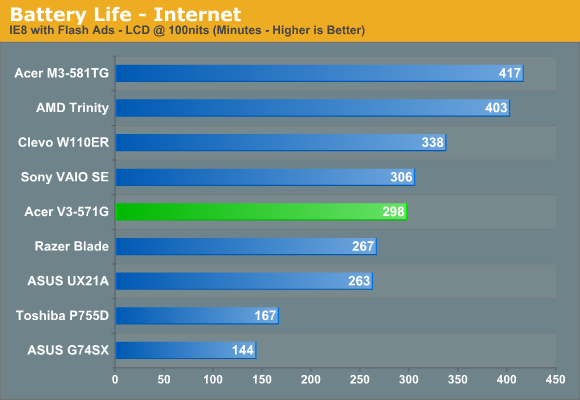
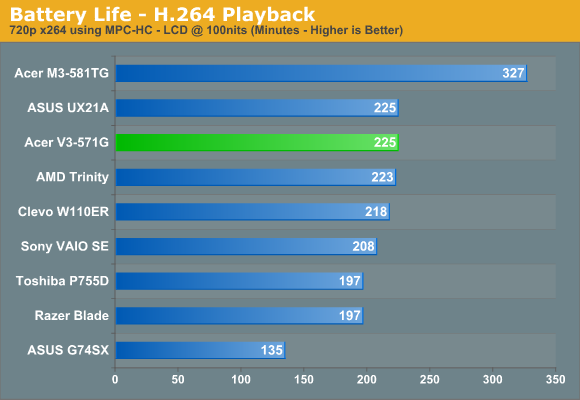
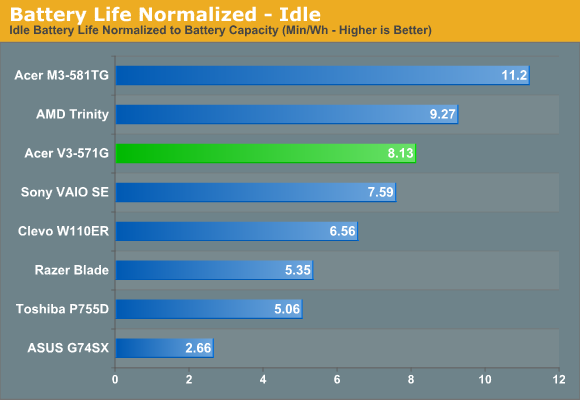
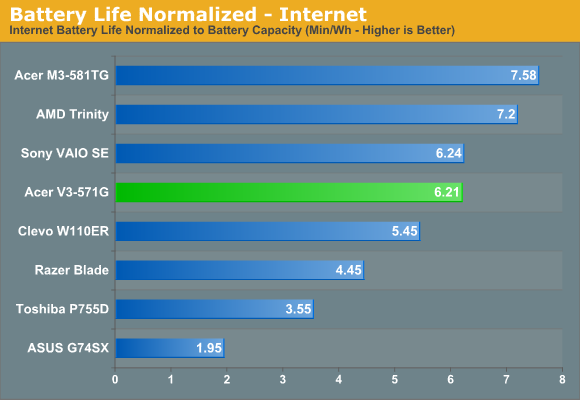
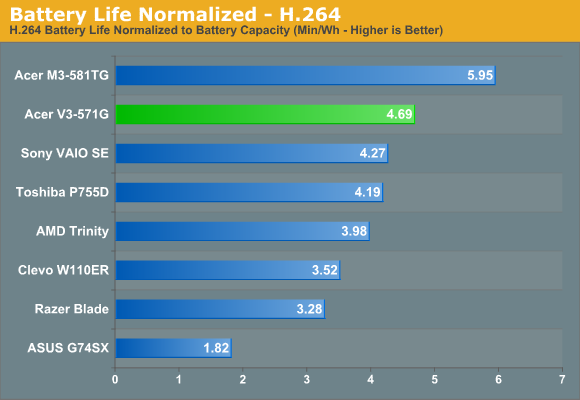
Actually, considering the capacity the battery life isn’t so bad. Maximum possible battery life is 6.5 hours, and typical use battery life for surfing the Internet is still five hours. Anyone interested in using the laptop to watch movies on a longer flight will note that you get just under four hours of H.264 playback from the hard drive, which is only enough to make it through two medium length films. Looking at the normalized battery life results, the Acer V3 rates near the top of the pack, with only the M3 Ultrabook beating it in all three tests and AMD’s Trinity leading in two of the three tests (but losing in normalized H.264 playback). Had Acer equipped the V3 with a 56Wh battery like the M3 or Trinity, we’d be looking at another 30 to 60 minutes of battery life.
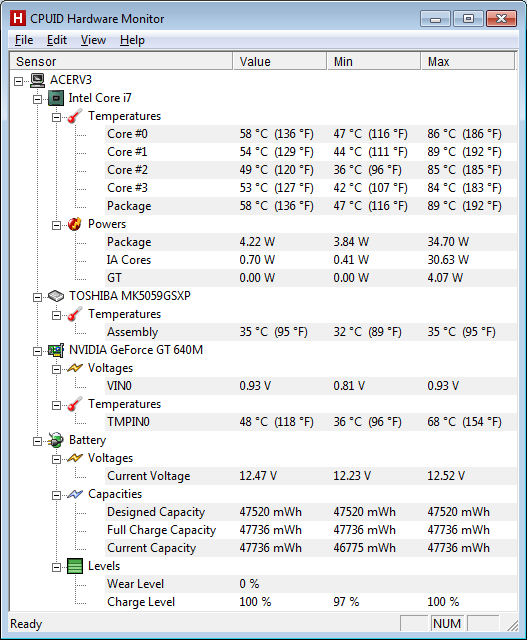
Looking at the thermal performance, it’s pretty clear that the V3 chassis provides sufficient cooling for the IVB and Kepler parts. During extended stress testing, the CPU did hit just under 90C on one core, but that was atypical—generally, under load we saw temperatures in the low to mid 80s. The GPU does even better, with a maximum temperature we recorded during stress testing of just 68C.
Noise levels are equally impressive, with idle noise near our testing floor of 30dB, coming in just slightly higher at 31dB. Under heavier CPU or GPU loads, noise creeps up to 33.5dB, with periodic increases to 34.5dB. With a maximum load on the CPU and GPU, we did manage to reach and stay at 35.6dB pretty much as long as we let the testing continue, but that's still pretty quiet for a laptop under full load. The only real concern I have with noise levels is that it appears we’re at maximum fan speed when we’re hitting ~36dB. Why is that a problem? It means that if the laptop happens to be in a more extreme environment (say, Arizona summer weather, with you sitting outside in 110F+ heat), there’s no room for the fan to try and compensate for added heat.
I actually covered the exhaust with my hand for a couple minutes to see if I could get a higher fan speed, with no success (and an uncomfortably hot hand). Interestingly, rather than getting hotter it appears both the CPU and GPU throttled a bit—or at least, I didn’t see core temperatures increase beyond the previously measured highs. This is worrisome as I have a friend with an older Gateway P-series FX notebook that behaves in a similar fashion, only now he’s getting to the point where the 3-year-old notebook occasionally overheats and crashes—something it didn’t do during the first couple years of use. Will the Acer V3 behave similarly in a couple years? Only time will tell, but I’d feel better if there was at least one or two more notches on the fan speed. I’d rather have a loud laptop that runs stably than a quiet laptop that crashes.










88 Comments
View All Comments
JarredWalton - Saturday, July 7, 2012 - link
It's not an "assumption" that chiclet is better, but I can't think of one thing about the old style "floating island" keyboard that is better to this new "floating chiclet". That's not to say that this keyboard is perfect, but as I note in the review, I did a fair amount of typing on the V3 and the keyboard is certainly usable without severe complaints by me -- someone that writes 5000 word articles for a living. Is it equal to some of the older ThinkPad keyboards? Not really, but I'm not sure ThinkPad has ever done a perfect keyboard layout with a 10-key either, outside of the W700 line. For a 15.6" keyboard with a 10-key, the layout is just about perfect, even if the key action could be improved.pullmyfoot - Saturday, July 7, 2012 - link
You guys should do a review of the Samsung Chronos 7 700Z5C. I just got one and its the perfect laptop IMO without breaking the bank.70% aluminum construction
A above average screen at 1600x900
1TB 7200RPM with 8GB SSD express cache
Rest of the specs are the same if not slightly better than this Acer.
apmon2 - Saturday, July 7, 2012 - link
Given that so many Laptops still seem to be sold with crappy screens and that good replacement screens can be got for less than $100, it would be great if AnandTech could write more about this.If you could write a separate article on how to switch laptop screens and what you need to consider, as well as review the different available after market LCD screens, perhaps more people would choose to switch their screens and not suffer from their crappy display.
This could even benefit those buying high-end laptops, if it becomes common to order the laptop with the cheapest display and then replace it with a high quality on later on, just as it is common to order the cheapest HDD and then replace it with an SSD.
E.g. Lenovo charge $250 for the full HD screen upgrade on the Thinkpad T530, whereas the screen costs less than $100 if bought separably. One also then has a better choice, be it matt vs glossy, IPS vs TN, high colour gamut or not, rather than the one choice offered by the manufacturer.
jabber - Saturday, July 7, 2012 - link
I'd like to see an article on what the costs are to the manufacturer for screens.Basically what does a standard 15" TN glossy 1366x768 screen cost compared to -
15" TN 1600x900 (glossy/non glossy)
15" TN 1920x1080 (glossy/non glossy)
15" IPS 1600x900
15" IPS 1920x1080
I havent included 16:10 as I don't wish to hope for too much.
JarredWalton - Saturday, July 7, 2012 - link
The manufacturers don't disclose their costs for individual components, so it's impossible to say what they pay. I've had one manufacturer insist that what we pay for an LCD on, e.g. LaptopScreens.com, is less than they would pay. That seems unlikely to me (if you're ordering 10,000 LCDs, you're not going to pay more than if you're ordering 1 screen, are you?) but they do note that there's also difficulty at times in procuring the required number of displays. My hunch is that LaptopScreens probably marks up the LCDs they sell by 10% over what they pay, and large manufacturers pay a bit less than them. But I could be wrong.chromatix - Saturday, July 7, 2012 - link
I have a 14" display from *1994* that can manage 115 dpi without much trouble. Bear in mind that 14" is the tube diagonal, not the display area, and that this is a fairly bog-standard "fishbowl" monitor. Driving it at 1152x870 results in the aforementioned 115dpi.Coincidentally, this is also approximately the density of both of my much newer flatscreen monitors, which are of course meant for viewing at a greater distance than a laptop. It is also the density of the roughly 2000-vintage ThinkPad that I rescued from the office scrap pile recently - with 1400x1050, the screen is excellently configured for coding, even if the viewing angles and colour reproduction are awful by modern standards. (It's very useful to have lots of *lines* of code on screen at once.)
My 2006 17" MBP pushes the density up to 130 dpi with 1920x1200. I have to go back to my 2000-vintage PowerBook G3 to get down to 100 dpi.
Meanwhile, a 15.6" laptop display with less than 1400 pixels across is going to be 100 dpi maximum. At laptop viewing distances, that's like putting standard definition up on a 50" TV - you can see the pixels without even trying. Antialiasing is a wonderful thing, but it has limits to what it can hide. On an old PowerBook it was forgivable because it was the best thing available (and the panel was decent) - but today, and with contrast numbers that make flip-up sunglasses look good...
Surely someone out there knows how to make a laptop with good build quality, good ergonomics, a big battery and a good screen, and doesn't mind reducing the performance a bit to suit the price? I don't even care if it's two inches thick, as long as the screen and the body aren't shiny - I would prefer to see my code and my game rather than my own ugly mug.
That's another point - thinness is vastly overrated. Comparing my PowerBook G3 to my MBP, they are the same depth, the MBP is 21% wider (15.4" vs 12.7") and the G3 is 70% thicker (0.98" vs. 1.7"). They're not much different in weight - the G3 is 2.8kg, the MBP is 3.1kg. But it's the MBP that feels "bigger". It also feels considerably more fragile to pick up - I feel the need to grab it by both sides, rather than levering it up by one side, even though intellectually I realise it's probably strong enough to withstand such treatment, and my other hand might be otherwise occupied.
Meanwhile, I still have a lot more difficulty putting both the MBP and my 15" AlBook - a total of 2.1" thickness - in the same bag, than I do just putting the G3 in. Part of that is, I think, because the G3 is more rounded at the edges, so it doesn't catch on things so easily. Little details like that - and thermal performance - matter a lot more than being thin. It's even worse when important functionality (such as recording dual-layer DVDs, or being able to replace the battery, RAM and hard disk without risking ruining the whole machine) are sacrificed in the name of the holy measurement.
Iketh - Sunday, July 8, 2012 - link
YEA SILVA!!!!!QuantumPion - Monday, July 9, 2012 - link
I got an Acer laptop last year with sandy bridge core i5 and nvidia GT 540M for $450 after instant rebate. The display sucks but $450 for a laptop fully capable of playing Skyrim and Battlefield 3 is hard to beat.DotNetGuru - Monday, July 9, 2012 - link
Just wanted to drop a comment to show my appreciation for this great review.Very well done. Thanks!!
rudolphna - Monday, July 9, 2012 - link
I actually just picked up the Trinity A8-4500M version of this laptop for $529 on newegg, and I have to say, though the screen isn't that great, overall it's a great deal for the price. I'm certainly not going to complain about the amount of horsepower I managed to get for $530. I also did order a Momentus XT 500GB, and 8GB of Corsair DDR3-1600 that should arrive tomorrow to hep up the performance a bit more. Once that's done, I doubt there are any other laptops on the market with this kind of value.